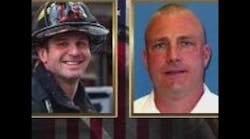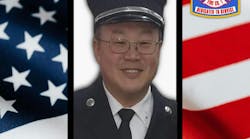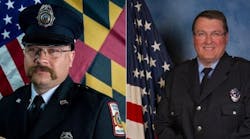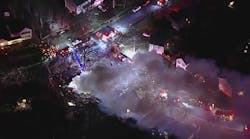Editor’s note: The National Institute for Occupational Safety and Health (NIOSH) Firefighter Fatality Investigation and Prevention Program conducts investigations of firefighter line-of-duty deaths to formulate recommendations for preventing future deaths and injuries. The program does not seek to determine fault or place blame on fire departments or individual firefighters, but to learn from these tragic events and prevent future similar events. NIOSH is a unit of the U.S. Centers for Disease Control and Prevention (CDC).
Firehouse® Magazine is pleased to join with NIOSH in presenting this valuable information. It is important to note that while some incidents that will be described here occurred several years ago, the information presented is valuable today. The accounts that follow are summaries of NIOSH investigations. The complete reports are available on the program website at www.cdc.gov/niosh/firehome.html.
SUMMARY
On March 17, 2000, a 31-year-old career firefighter/engineer died after the apparatus (Truck 1) that he was driving collided with an Amtrak train at a railroad crossing. The victim was returning to the station after a false alarm. Responding in addition to Truck 1 were Squad 1, Engine 2, Engine 11, Engine 1, Squad 3 and the battalion commander (BC-1). Truck 1 stopped behind a civilian vehicle on the west side of a railroad crossing consisting of three sets of tracks. The safety gates at the crossing were down, the warning lights were activated and a freight train was moving slowly. The freight train stopped after it cleared the crossing to wait for a signal ahead. Truck 1 started to go around the first safety gate and over the track. Witness 1, in a vehicle behind Truck 1, saw a tanker car at the end of the freight train that obstructed the northbound view of the tracks, and he heard a train whistle. Witness 2, waiting in a vehicle on the east side of the crossing, saw a southbound Amtrak train approaching. He also saw Truck 1 driving around the first safety gate, so he honked his horn and flashed his headlights to warn the driver. Truck 1 continued around the safety gate and traveled into the path of the train, which struck the truck’s left front corner and the bucket of the aerial ladder. The victim was ejected, landing behind the truck’s left rear dual wheel. He was killed instantly.
RECOMMENDATIONS
- Fire departments should ensure firefighters follow standard operating procedures (SOPs) and state motor vehicle codes for safely driving and operating emergency vehicles.
SUMMARY
On Jan. 17, 2000, a 47-year-old volunteer fire chief died after he lost control of the truck he was driving, and the truck rolled three times and came to rest on an embankment. The victim lost control of the truck as he approached a slight curve in the roadway. The truck began to skid, and the right tires traveled onto the shoulder. Continuing on the shoulder, the truck entered a ditch, became airborne, crossed a lane on a side street and struck a center median. The truck crossed a second lane on a side street, struck a guardrail and flipped end over end until it landed in a concrete culvert. The victim was killed instantly.
CAUSE OF DEATH
The death certificate lists the cause of death as massive neck trauma and upper chest trauma.
RECOMMENDATIONS
- Fire departments should ensure all apparatus are kept under a maintenance schedule that is documented.
SUMMARY
On March 7, 2002, a 28-year-old male volunteer firefighter (Victim 1) and a 41-year-old male career firefighter (Victim 2) died after becoming trapped in a basement. Victim 1 manned the nozzle while Victim 2 provided backup on the handline as they entered the house. After they entered the structure, the floor collapsed, trapping both victims in the basement. A career captain joining the firefighters near the time of the collapse was injured trying to rescue one of the firefighters. Crew members responded immediately and attempted to rescue the victims; however, the heat and flames overcame both victims and eliminated any rescue efforts from the garage entrance.
CAUSE OF DEATH
The county medical examiner listed the cause of death for both victims as asphyxia due to the inhalation of smoke and soot.
RECOMMENDATIONS
- Fire departments should ensure that the incident commander (IC) is clearly identified as the only individual responsible for the overall coordination and direction of all activities at an incident.
SUMMARY
On June 15, 2003, a 39-year-old male career lieutenant (Victim 1) and a 39-year-old male career firefighter (Victim 2) died while trying to exit a commercial structure following a partial collapse of the roof supported by lightweight metal trusses (bar joists). The victims were searching for fire and possible entrapment of the store manager. Both victims were in the back of the store operating a handline on the fire that was rolling overhead above a suspended ceiling. A truck company was pulling ceiling tiles searching for fire extension when a possible backdraft explosion occurred in the void space above the ceiling tiles. Victim 1 called for everyone to back out due to the intense heat. At this point, the roof system at the rear of the structure began to fail, sending debris down on top of the firefighters. Victim 1 and Victim 2 became separated from the other firefighters and were unable to escape. Crews were able to remove Victim 2 within minutes and transported him to a local hospital, where he succumbed to his injuries the following day. Soon after Victim 2 was removed, the rear of the building collapsed, preventing further rescue efforts until the fire was brought under control. Victim 1 was recovered approximately 1½ hours later.
CAUSES OF DEATH
The cause of death as reported by the county medical examiner for Victim 1 was thermal burns. The cause of death for Victim 2 was thermal inhalation injury.
RECOMMENDATIONS
- Fire departments should ensure that the first-arriving company officer does not become involved in firefighting efforts when assuming the role of incident command.
- Fire departments should ensure that the incident commander (IC) conducts an initial size-up and risk assessment of the incident scene before beginning interior firefighting operations.
- Fire departments should conduct pre-incident planning and inspections for mercantile and business occupancies.
- Fire departments should ensure that ventilation is closely coordinated with the fire attack.
- Fire departments should ensure that firefighters immediately open ceilings and other concealed spaces whenever a fire is suspected of being in a truss system.
- Fire departments should ensure that firefighters performing firefighting operations under or above trusses are evacuated as soon as it is determined that the trusses are exposed to fire.
- Fire departments should consider using a thermal imaging camera as a part of the size-up operation to aid in locating fires in concealed areas.
- Additionally, municipalities should consider requiring specific building construction information on an exterior placard.









